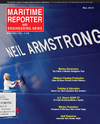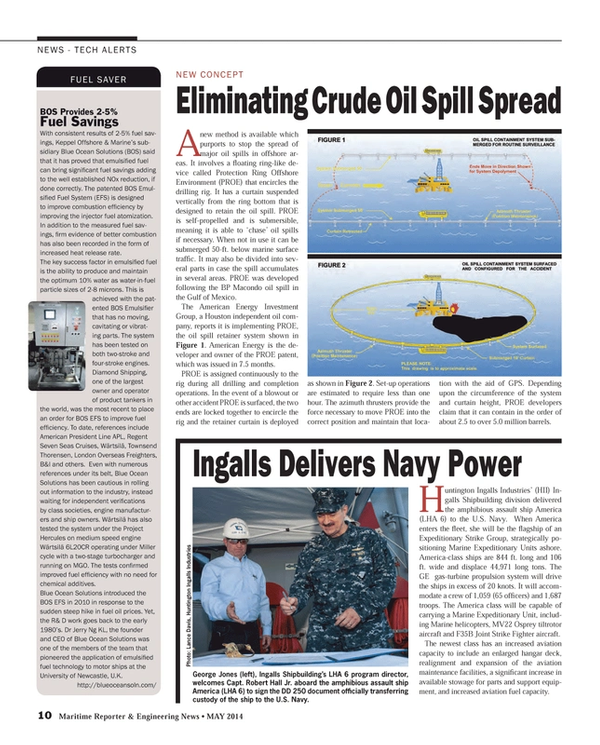
New Concept Eliminating Crude Oil Spill Spread
A new method is available which purports to stop the spread of major oil spills in offshore areas. It involves a floating ring-like device called Protection Ring Offshore Environment (PROE) that encircles the drilling rig. It has a curtain suspended vertically from the ring bottom that is designed to retain the oil spill. PROE is self-propelled and is submersible, meaning it is able to ‘chase’ oil spills if necessary. When not in use it can be submerged 50-ft. below marine surface traffic. It may also be divided into several parts in case the spill accumulates in several areas. PROE was developed following the BP Macondo oil spill in the Gulf of Mexico.
The American Energy Investment Group, a Houston independent oil company, reports it is implementing PROE, the oil spill retainer system shown in Figure 1. American Energy is the developer and owner of the PROE patent, which was issued in 7.5 months.
PROE is assigned continuously to the rig during all drilling and completion operations. In the event of a blowout or other accident PROE is surfaced, the two ends are locked together to encircle the rig and the retainer curtain is deployed as shown in Figure 2. Set-up operations are estimated to require less than one hour. The azimuth thrusters provide the force necessary to move PROE into the correct position and maintain that location with the aid of GPS. Depending upon the circumference of the system and curtain height, PROE developers claim that it can contain in the order of about 2.5 to over 5 million barrels.
(As published in the May 2014 edition of Maritime Reporter & Engineering News - http://magazines.marinelink.com/Magazines/MaritimeReporter)
Read New Concept Eliminating Crude Oil Spill Spread in Pdf, Flash or Html5 edition of May 2014 Maritime Reporter
Other stories from May 2014 issue
Content
- New Concept Eliminating Crude Oil Spill Spread page: 10
- BOS Provides 2-5% Fuel Savings page: 10
- Floating Production System Orders Outlook page: 12
- The Treatment of Foreign Seafarers page: 16
- Hydrodynamic Software Suites page: 19
- SEEMP: Potential Win-win for Commercial Vessels page: 20
- Ergonomic Controls Innovation for ECDIS, Bridge Controls page: 22
- To Litigate, or Arbitrate? That is the Question page: 24
- Experts Weigh Training Factor into Sewol Tragedy page: 26
- Does e-Learning Work? page: 30
- Elmer A. Sperry: Pioneer of Modern Naval Tech page: 32
- Aviator & Engineer: Lawrence Burst Sperry page: 38
- U.S. Navy's AGOR 27: R/V Neil Armstrong page: 40
- Classification Leaders Weigh in on Marine Propulsion page: 44
- Interview: Rich Hobbie, Water Quality Insurance Syndicate (WQIS) page: 48
- Mammoet: World’s Biggest Crawler Crane Installs Legs on Ship page: 52
- ALP Tugs Get Rolls-Royce Deck Equipment page: 52
- Traction and Control System for Tugboat Winches page: 53
- Townsville Opts for a Liebherr LHM 420 page: 53
- WASSP Goes Wireless with New Remote Mapping System page: 55
- Danelec’s 3G VDR page: 55
- ABB Energy Management System page: 55
- Transas Liquid Cargo Handling Simulator page: 55
- Color LCD Radar from SI-TEX page: 55
- Martek: Network-Connected ECDIS page: 55
- Vessel Optimization Data page: 55
- Lilaas L01 Control page: 56
- Northport Actisense Engine Monitoring Units page: 56
- MarineNav’s New Line of Displays page: 56
- Voyager Planning Station Adds AtoBviaC Distance Tables page: 56
- L-3 SAM for DanTysk Wind Project page: 56
- Navis Joystick System for New Yacht page: 56
- Ship-to-Turbine Oil Change System page: 57
- USN Orders Hoffer Flow Measurement Systems page: 57
- Phoenix Launches HDL-LED Series page: 57
- New Line of Safety Switches page: 57
- HAL Retrofits VDRs on Fleet page: 57
- New Steering System page: 57


